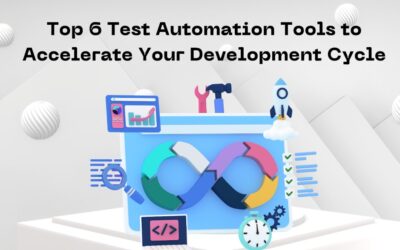AI (Artificial Intelligence) is the process through which machines programmed to mimic and think like humans simulate human intelligence and perform functions like humans. AI can also be used to define machines that show human traits or rather traits of a human mind such as problem-solving and learning.
Artificial intelligence can take actions and rationalize them, coming up with the best opportunity to satisfy a specific need. Machine learning is often used with artificial intelligence. However, machine learning can be seen as part of artificial intelligence. It is the concept used by software programs to learn and adapt to new information without any input from humans.

When it comes to automated testing of APIs, artificial intelligence is playing a crucial role. APIs (Applications Programming Interfaces) are computing interfaces through which applications communicate and share information. For them to work well and meet all their requirements, they need to be tested thoroughly. It is through testing that organizations can protect themselves from fraud and any vulnerabilities that might leave them exposed.
One of the best ways of testing APIs is automated API testing. It ensures that every aspect of the API is tested compared to manual testing that might leave parts of the API due to human error. How can organizations use artificial intelligence in the automated testing of their APIs?
Running the Right Tests
Imagine a situation where a small change has been made on an API and an organization has to test the entire API because they cannot trace the exact change. This is not good practice. Continuous integration and testing generate so much data from the number of tests done. It gets very difficult to have someone going through all this data looking for any common patterns that might be available.
This makes it necessary for organizations to implement an API testing framework that tells them the number of tests they should run after making changes to their code for them to know if the change is good or not. This is where artificial intelligence comes in. With AI, organizations are able to know the smallest number of tests they can perform on changed code to determine whether the change is good or not.
Doing Visual Validation of the User Interface
Visual testing is a process that is made to validate the user interface of an application to make sure that users get what they need. It is different from functional testing that checks the functionality of an application. Visual testing seeks to make sure that the user interface is correct and all its elements are in the right shape, size, color, and position, and that they do not overlap or hide other elements of the application.
Even though organizations had previously been using manual testing to validate the user interface of their applications, artificial intelligence has come to make things easier for them. Today, organizations can use artificial intelligence to create tests that detect all the UI bugs and validate the correctness of the interface without one having to tell it what to check. In addition, AI shows everything, including things that a human tester would not see.
Spidering Artificial Intelligence
Today, organizations are able to use artificial intelligence in a process called spidering that involves automatically writing tests for an API. For instance, you can point the testing tool using artificial intelligence towards your API for it to crawl the API automatically. During this process, the tool collects data related to the API, such as load times, features of the API, and its code among others. This process is continuous.
Over a period of time, the tool creates a set of data and trains the artificial intelligence features of the tool about the models of data that the API accepts. As the testing tool is running, it compares the current data models with the ones that it has learned, and raises a flag if there are any differences. This way, organizations can address the issues to make sure that their APIs work well without any problems.
Incorporating services like LangChain, which is known for orchestrating large language models (LLMs), allows organizations to take their AI-driven testing tools to the next level. It enhances the AI’s ability to process and utilize the data collected, while detecting subtle discrepancies and suggesting actionable optimizations.
Creating Reliable Tests
Sometimes, an organization building an API might have one of its developers making changes to the API. For instance, they might make a small change, such as changing a property name. When tests are done, they fail, leaving them wondering what could have gone wrong. Artificial intelligence can solve this for them.
Testing tools powered by artificial intelligence can automatically learn about such changes on the API, making the tests on their own and letting organizations know where the changes are, and if the changes work for the API. This makes the process of testing APIs reliable and maintainable.
But how do they do this? Artificial intelligence makes it possible for testing tools to learn everything about the API, including the relationship between all its object models and any changes that might be made to it. After that, the tools are able to make decisions on their own. This makes API tests easy and reliable.
Predicting Future Failures
Building and implementing an API requires that organizations need to keep a close eye on the performance of the API throughout its lifetime. Imagine a situation where you have tested your API and everything works well, as it is supposed to.
However, once the API is published and adopted by consumers, you start getting issues that initially worked well. There are many reasons for this, such as how your users use the API.
Using artificial intelligence when testing your APIs can help you solve this. When testing, AI learns everything about your API and projects all the possible situations that the API might find itself in when published. All these situations are tested, and any issues that might arise in the future are identified. This way, organizations are able to ensure that their APIs will work well, no matter the situations they find themselves in when published.
Also, consider adopting these additional tips:
- Comprehensive Testing Coverage: Ensure your testing strategy includes various tests such as functional, load, stress, security, and compatibility. This helps uncover issues that might not be predicted by AI alone.
- Continuous Integration/Continuous Deployment (CI/CD): Implement these pipelines for the quick detection of defects early in the development cycle.
- Real-time Monitoring and Analytics: Deploying these tools provide real-time insights about API performance and usage.
- User Behavior Simulation: Simulate real user interactions with your API through synthetic transactions that mimic typical and atypical user behaviors. These simulations help validate AI predictions.
- Feedback Loops from Production: Use feedback from actual API consumers to refine and improve the API, integrating logs, error reports, and performance data back into the development cycle.
- Versioning Strategy: Maintain proper API versioning to manage changes and ensure backward compatibility, minimizing disruption for existing users while rolling out updates.
- Security Practices: Implement robust security practices, including regular audits, penetration testing, and adherence to protocols like OAuth and JWT. This protects your API from various security threats.
- Scalability Tests: Regularly test your API for scalability to ensure it can handle increased loads as user numbers grow, involving tests under various loads to monitor API performance under stress.
By combining these strategies with AI-enhanced testing, you can significantly improve the performance and reliability of your APIs, ensuring they perform well under all expected — and unexpected — conditions.
Conclusion
Automated API testing has made the whole process of API testing and management easier. Today, organizations are able to focus on other important things while leaving testing tools to handle the testing for them. In addition, the chances of leaving any aspect of the API without being tested are very low with automated testing. It is, therefore, important for organizations to invest in automated API testing guided by artificial intelligence.









0 Comments